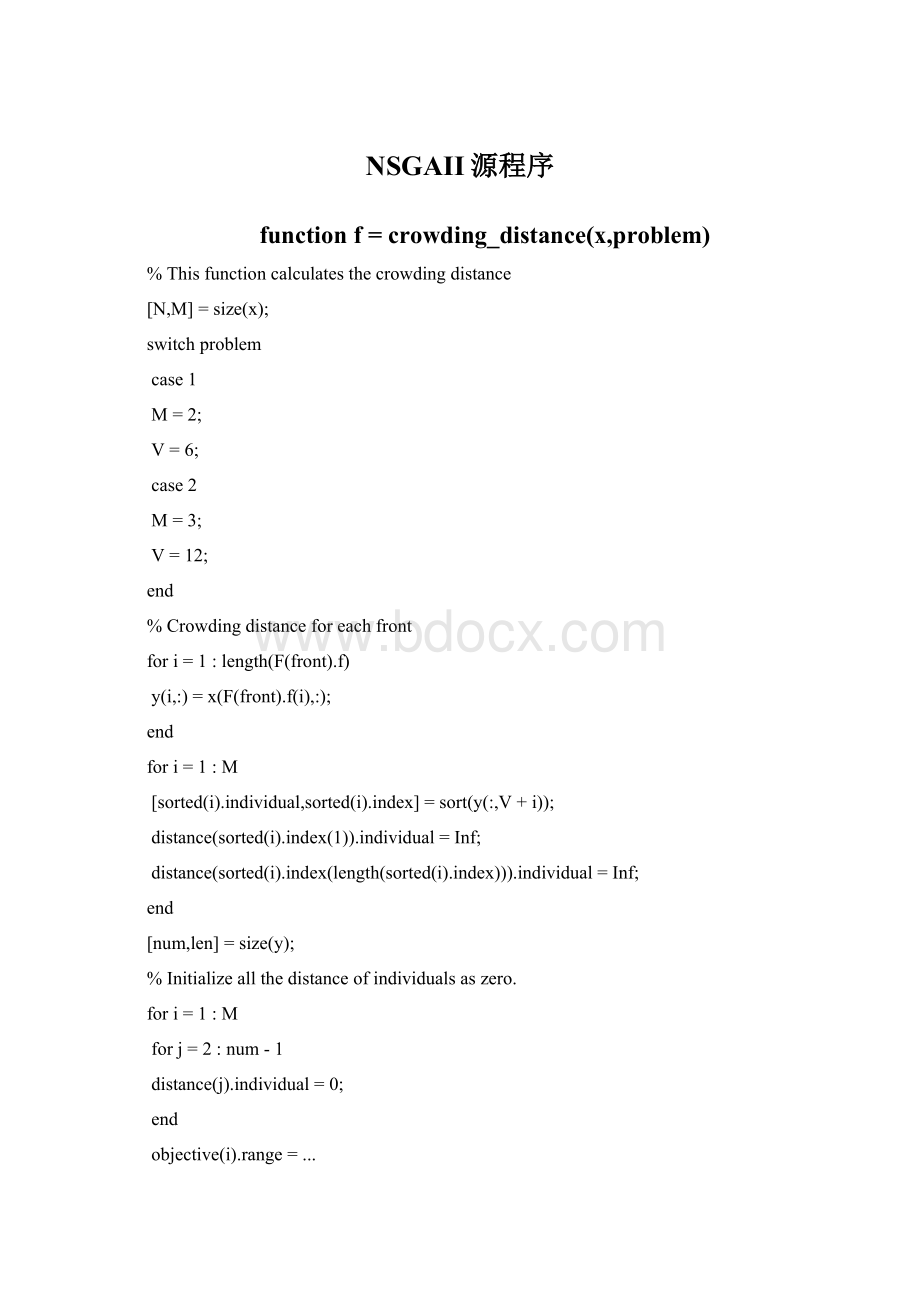NSGAII源程序Word格式文档下载.docx
《NSGAII源程序Word格式文档下载.docx》由会员分享,可在线阅读,更多相关《NSGAII源程序Word格式文档下载.docx(17页珍藏版)》请在冰豆网上搜索。

objective(i).range=...
sorted(i).individual(length(sorted(i).individual))-...
sorted(i).individual
(1);
%Maximumandminimumobjectivesvaluefortheithobjective
%Caluclatethecrowdingdistanceforfrontone.
distance(j).individual=distance(j).individual+...
(sorted(i).individual(j+1)-sorted(i).individual(j-1))/...
objective(i).range;
y(sorted(i).index(j),M+V+2)=distance(j).individual;
<
/PRE
PublishedwithMATLAB®
7.0
functionf=genetic_operator(parent_chromosome,pro,mu,mum);
%Thisfunctionisutilizedtoproduceoffspringsfromparentchromosomes.
%Thegeneticoperatorscorssoverandmutationwhicharecarriedoutwith
%slightmodificationsfromtheoriginaldesign.Formoreinformationread
%thedocumentenclosed.
[N,M]=size(parent_chromosome);
switchpro
p=1;
was_crossover=0;
was_mutation=0;
l_limit=0;
u_limit=1;
N
ifrand
(1)<
0.9
child_1=[];
child_2=[];
parent_1=round(N*rand
(1));
ifparent_1<
1
parent_1=1;
parent_2=round(N*rand
(1));
ifparent_2<
parent_2=1;
whileisequal(parent_chromosome(parent_1,:
),parent_chromosome(parent_2,:
))
parent_1=parent_chromosome(parent_1,:
parent_2=parent_chromosome(parent_2,:
forj=1:
V
%SBX(SimulatedBinaryCrossover)
%Generatearandomnumber
u(j)=rand
(1);
ifu(j)<
=0.5
bq(j)=(2*u(j))^(1/(mu+1));
else
bq(j)=(1/(2*(1-u(j))))^(1/(mu+1));
child_1(j)=...
0.5*(((1+bq(j))*parent_1(j))+(1-bq(j))*parent_2(j));
child_2(j)=...
0.5*(((1-bq(j))*parent_1(j))+(1+bq(j))*parent_2(j));
ifchild_1(j)>
u_limit
child_1(j)=u_limit;
elseifchild_1(j)<
l_limit
child_1(j)=l_limit;
ifchild_2(j)>
child_2(j)=u_limit;
elseifchild_2(j)<
child_2(j)=l_limit;
child_1(:
V+1:
M+V)=evaluate_objective(child_1,pro);
child_2(:
M+V)=evaluate_objective(child_2,pro);
was_crossover=1;
was_mutation=0;
parent_3=round(N*rand
(1));
ifparent_3<
parent_3=1;
%Makesurethatthemutationdoesnotresultinvariablesoutof
%thesearchspace.ForboththeMOP'
stherangefordecisionspace
%is[0,1].Incasedifferentvariableshavedifferentdecision
%spaceeachvariablecanbeassignedarange.
child_3=parent_chromosome(parent_3,:
r(j)=rand
(1);
ifr(j)<
0.5
delta(j)=(2*r(j))^(1/(mum+1))-1;
delta(j)=1-(2*(1-r(j)))^(1/(mum+1));
child_3(j)=child_3(j)+delta(j);
ifchild_3(j)>
child_3(j)=u_limit;
elseifchild_3(j)<
child_3(j)=l_limit;
child_3(:
M+V)=evaluate_objective(child_3,pro);
was_mutation=1;
was_crossover=0;
ifwas_crossover
child(p,:
)=child_1;
child(p+1,:
)=child_2;
was_cossover=0;
p=p+2;
elseifwas_mutation
)=child_3(1,1:
M+V);
p=p+1;
f=child;
PublishedwithMATLAB®
functionf=initialize_variables(N,problem)
%functionf=initialize_variables(N,problem)
%N-Populationsize
%problem-takesintegervalues1and2where,
%'
1'
forMOP1
2'
forMOP2
%
%ThisfunctioninitializesthepopulationwithNindividualsandeach
%individualhavingMdecisionvariablesbasedontheselectedproblem.
%M=6forproblemMOP1andM=12forproblemMOP2.Theobjectivespace
%forMOP1is2dimensionalwhileforMOP2is3dimensional.
%BoththeMOP'
shas0to1asitsrangeforallthedecisionvariables.
min=0;
max=1;
M=6;
K=8;
M=12;
K=15;
%Initializethedecisionvariables
f(i,j)=rand
(1);
%i.ef(i,j)=min+(max-min)*rand
(1);
%Evaluatetheobjectivefunction
f(i,M+1:
K)=evaluate_objective(f(i,:
),problem);
Non-DonimationSort
Thisfunctionsortthecurrentpopultionbasedonnon-domination.Alltheindividualsinthefirstfrontaregivenarankof1,thesecondfrontindividualsareassignedrank2andsoon.Afterassigningtherankthecrowdingineachfrontiscalculated.
front=1;
%Thereisnothingtothisassignment,usedonlytomanipulateeasilyin
%MATLAB.
F(front).f=[];
individual=[];
%Numberofindividualsthatdominatethisindividual
individual(i).n=0;
%Individualswhichthisindividualdominate
individual(i).p=[];
dom_less=0;
dom_equal=0;
dom_more=0;
fork=1:
if(x(i,V+k)<
x(j,V+k))
dom_less=dom_less+1;
elseif(x(i,V+k)==x(j,V+k))
dom_equal=dom_equal+1;
dom_more=dom_more+1;
ifdom_less==0&
dom_equal~=M
individual(i).n=individual(i).n+1;
elseifdom_more==0&
individual(i).p=[individual(i).pj];
ifindividual(i).n==0
x(i,M+V+1)=1;
F(front).f=[F(front).fi];
%Findthesubsequentfronts
while~isempty(F(front).f)
Q=[];
fori=1:
if~isempty(individual(F(front).f(i)).p)
forj=1:
length(individual(F(front).f(i)).p)
individual(individual(F(front).f(i)).p(j)).n=...
individual(individual(F(front).f(i)).p(j)).n-1;
ifindividual(individual(F(front).f(i)).p(j)).n==0
x(individual(F(front).f(i)).p(j),M+V+1)=...
front+1;
Q=[Qindividual(F(front).f(i)).p(j)];
front=front+1;
F(front).f=Q;
[temp,index_of_fronts]=sort(x(:
M+V+1));
length(index_of_fronts)
sorted_based_on_front(i,:
)=x(index_of_fronts(i),:
current_index=0;
%Findthecrowdingdistanceforeachindividualineachfront
forfront=1:
(length(F)-1)
objective=[];
distance=0;
y=[];
previous_index=current_index+1;
)=sorted_based_on_front(current_index+i,:
current_index=current_index+i;
%Sorteachindividualbasedontheobjective
sorted_based_on_objective=[];
[sorted_based_on_objective,index_of_objectives]=...
sort(y(:
length(index_of_objectives)
sorted_based_on_objective(j,:
)=y(index_of_objectives(j),:
f_max=...
sorted_based_on_objective(length(index_of_objectives),V+i);
f_min=sorted_based_on_objective(1,V+i);
y(index_of_objectives(length(index_of_objectives)),M+V+1+i)...
=Inf;
y(index_of_objectives
(1),M+V+1+i)=Inf;
length(index_of_objectives)-1
next_obj=sorted_based_on_objective(j+1,V+i);
previous_obj=sorted_based_on_objective(j-1,V+i);
if(f_max-f_min==0)
y(index_of_objectives(j),M+V+1+i)=Inf;
y(index_of_objectives(j),M+V+1+i)=...
(next_obj-previous_obj)/(f_max-f_min);
distance=[];
distance(:
1)=zeros(length(F(front).f),1);
1)=distance(:
1)+y(:
M+V+1+i);
y(:
M+V+2)=distance;
y=y(:
1:
M+V+2);
z(previous_index:
current_index,:
)=y;
f=z();
MainFunction
MainprogramtoruntheNSGA-IIMOEA.Readthecorrespondingdocumentationtolearnmoreaboutmultiobjectiveoptimizationusingevolutionaryalgorithms.initialize_variableshastwoarguments;
Firstbeingthepopulationsizeandthesecondtheproblemnumber.'
correspondstoMOP1and'
correspondstoMOP2.
Contents
∙Initializethevariables
∙Sorttheinitializedpopulation
∙Starttheevolutionprocess
∙Result
∙Visualize
Initializethevariables
Declarethevariablesandinitializetheirvaluespop-populationgen-generationspro-problemnumber
pop=200;
gen=1;
pro=1;
%Misthenumberofobjectives.
%Visthenumberofdecisionvariables.Inthiscaseitis
%difficulttovisualizethedecisionvariablesspacewhilethe
%objectivespaceisjusttwodimensional.
%Initializethepopulation
chromosome=initialize_variables(pop,pro);
Sorttheinitializedpopulation
Sortthepopulationusingnon-domination-sort.Thisreturnstwocolumnsforeachindividualwhicharetherankandthecrowdingdistancecorrespondingtotheirpositioninthefronttheybelong.
chromosome=non_domination_sort_mod(chromosome,pro);
Starttheevolutionprocess
%Thefollowingareperformedineachgeneration
%Selecttheparents
%PerfromcrossoverandMutationoperator
%PerformSelection
gen
%Selecttheparents
%Parentsareselectedforreproductiontogenerateoffspring.The
%originalNSGA-IIusesabinarytournamentselectionbasedonthe
%crowded-comparisionoperator.Theargumentsare
%pool-sizeofthematingpool.Itiscommontohavethistobehalfthe
%populationsize.
%tour-Tournamentsiz